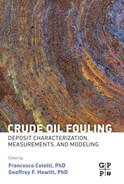Chapter Six
Concluding Remarks
Abstract
The final chapter (Chapter 6) summarizes the current state of knowledge on crude oil fouling and attempts to predict how the subject will develop into the future.
Keywords
Crude oil foulingAs seen from Chapters 1–5, crude oil fouling is a highly complex process, reflecting the complex nature of crude oil itself. Crude oil composition and behavior change from source to source, reflecting the wide variety of prehistoric events that led to the original formation of the crude oil. However, the supplier of products arising from crude oil wishes to make these products relatively independent of the source and the crude oil distillation process is an important tool in achieving product consistency. As demonstrated, fouling of heat exchangers in the preheat train leads to a significant increase in the cost of this distillation process.
There are many types of fouling (see Chapter 2), but it seems likely that the dominant mechanism in crude oil fouling is chemical reaction based. The deposits are subject to important aging processes that change the physical nature of the deposit with time and it is important to recognize these processes within any meaningful model of the fouling process.
The economic importance of crude oil fouling and its formidable complexity make it absolutely essential to continue research on this topic. Thus, in one sense, the work presented in this book is a kind of “progress report” on this research; it will be expected to continue in the future. However, what was new in the CROF project mentioned in Chapter 1, and the associated studies which led to most of the work reported here, was the multidisciplinary approach in which a wide variety of skills were brought together to attack the problem. The themes of this work can be briefly sated as follows:
• Experiments on fouling. Several new initiatives were taken in gathering experimental data on fouling. These ranged from the use of microbomb reactors (Chapter 3, Section 1), the development of a rotating cell device to study fouling under controlled conditions (Chapter 3, Section 2), the development of a novel method for fouling layer thickness measurement (Chapter 4, Section 4), and the construction of a major new facility for studying fouling under realistic conditions (Chapter 3, Section 3).
• Characterization of fouling deposits. Here, methods were developed that allow determination of the chemical structure and molecular weight of deposits (Chapter 4, Section 1 and Section 2) and also allow the location of various species on the surface of a deposit (chemical imaging, Chapter 4, Section 3).
• Modeling. Here, the modeling efforts ranged from the molecular scale in which the determination of key parameters such as diffusion coefficients and fluid physical properties was facilitated and the development of new equations of state that accounted for the presence of large molecules such as asphaltenes (Chapter 5, Section 2), the modeling of the fundamental processes of foulant deposition and aging (Chapter 5, Section 3), and the modeling of and prediction of data from operating plants (Chapter 5, Section 4).
This multidisciplinary effort has already brought several benefits and provided useful insights in this complex field of study. However, to give heat transfer equipment engineers and refinery operators the possibility of optimizing their design and operations, it is important that the work continues. Key areas of focus for this ongoing work are as follows:
• The generation of data on fouling under conditions closely matching those encountered in industry in apparatus such as the HIPOR facility described in Chapter 3. Testing crude oils under controlled conditions allows the determination of the effects that individual variables have on the fouling behavior. The use of such equipment is essential not only for determining the fundamental parameters governing fouling but also for testing possible fouling mitigation strategies and technologies (e.g., coatings, chemicals, tube inserts).
• The further development of reliable analytical techniques described in Chapter 4 and protocols that allow the characterization of oils and samples of deposits from both experimental testing facilities and refinery heat exchangers. Understanding what the species deposited are, especially if this can be done with in situ heating. This will help to shed light on the underlying mechanisms dominating the fouling process.
• Achieving the vision of a truly predictive multiscale model for fouling in heat exchangers that does not rely on past data to simulate fouling behavior as a function of crude oil composition, process conditions, and equipment design. This means both sharpening the existing tools, presented in Chapter 5, that describe the different scales of investigation and integrating them in a coherent framework.
As a part of this multidisciplinary approach, the close collaboration between academia and industry is a pivotal activity. Industrial experience and practical needs should drive the overall direction of the fundamental research. Data and deposits from the plant should be carefully analyzed to provide actionable information for operating personnel and heat exchanger designers that enable them to manage, mitigate, and, ideally, eliminate fouling.
It is believed that the multidisciplinary approach described in this book represents a paradigm shift in the approach to crude oil fouling studies, and that it can (and should) be extended to other systems (e.g., pipelines and upstream equipment). The problem is an ongoing one and one may expect that research will continue!
..................Content has been hidden....................
You can't read the all page of ebook, please click here login for view all page.
